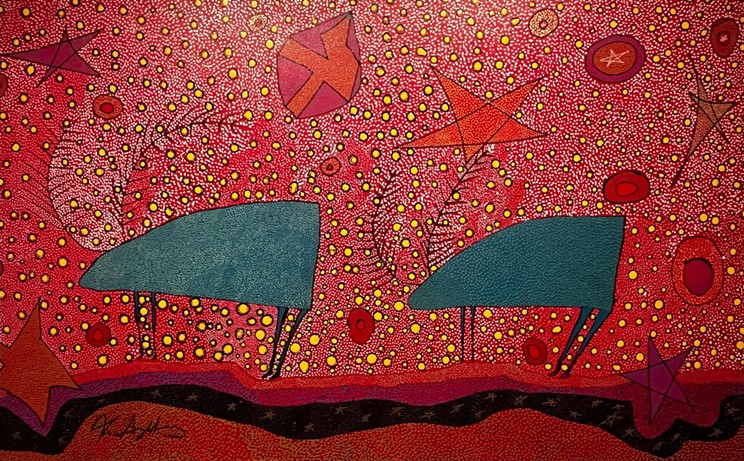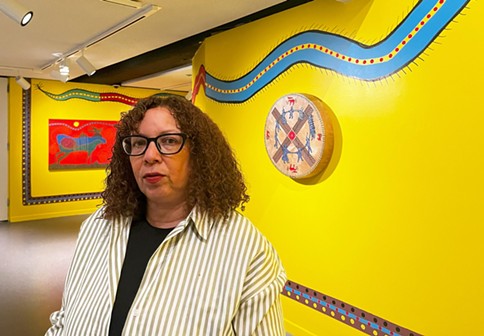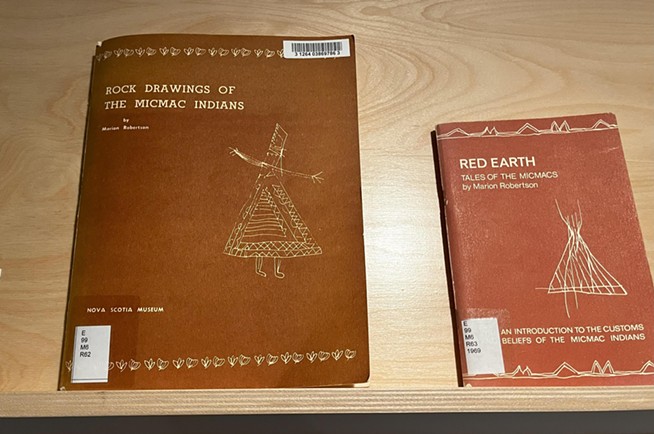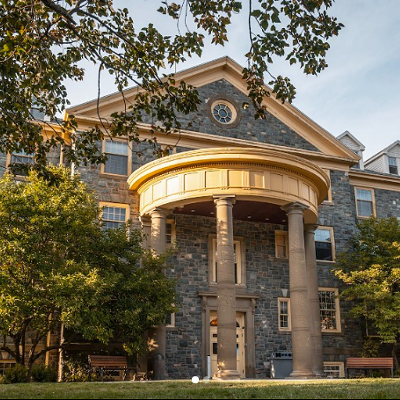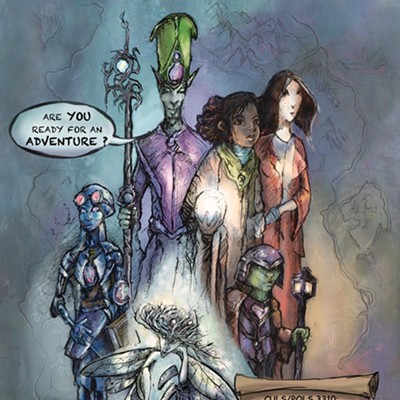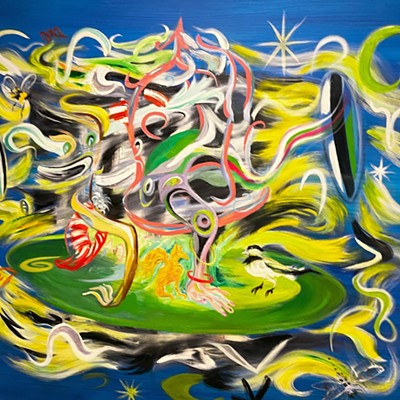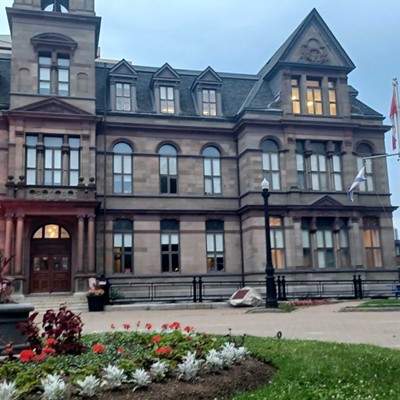Alan Syliboy’s largest retrospective ever is up at the Dalhousie Art Gallery (DAG), until Aug. 11.
The Journey So Far exhibition spans 50 years of work from the prolific self-taught Mi’kmaw artist from Millbrook First Nation. It offers a wide and diverse display of Syliboy’s multimedia work that continually draws material and figurative inspiration from Mi’kmaw culture, language, art and storytelling, including the repeating presence of red ochre, figures from Mi’kmaw petroglyphs and mythical characters from two Mi’kmaw textual stories found in their original language.
Thinking about the feeling his show gives, Syliboy says, "it's the scale of it all—50 years. I went through a lot of different periods in that time and you can see the progression and the process happening and evolving.
“You get a much bigger sense than just one show—this is many shows all together.”
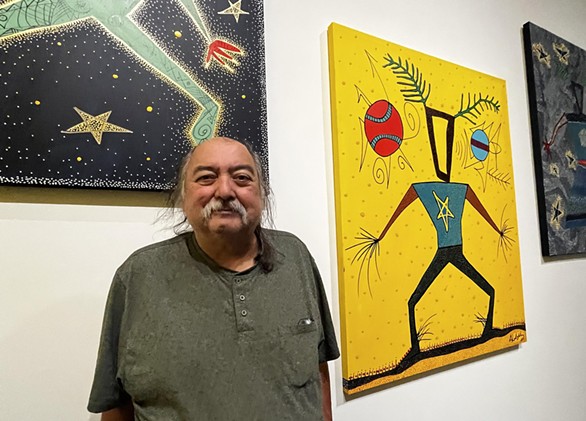
Alan Syliboy standing within his 50-year retrospective show, The Journey So Far.
The Journey So Far ranges from Syliboy’s early watercolour and pen drawings, to animations, to his daily drums, to mixed-media collages including his photography work, to large-scale painting, to signed copies of his illustrated books and to a sprawling giant-sized mural of a horned serpent—or Jipijka’m—painted on the gallery’s largest wall that weaves its way around the corner into a smaller gallery room within the show.
Pamela Edmonds, DAG’s curator and director, was part of a team of helpers who were up on ladders painting the snake with Syliboy. “I've known about his work since the early ’90s,” says Edmonds, who is African Nova Scotian. Edmonds studied and lived away from Nova Scotia for many years, but returned as curator and director at DAG in 2022.
In the late ’90s, Edmonds was working at a small art gallery on Barrington Street, which was a project of the multicultural association of Nova Scotia. Syliboy had a show called Journey when she was working there.
“I just remember the work being so striking,” says Edmonds, ”as well as his story, of wanting to connect with the Mi’kmaw community and wanting to get stories about the language and culture out to broader audiences.”
Edmonds says she’s “very much interested in grassroots artists that are working with community, that maybe are not necessarily taken up by the broader contemporary art community, but that are really interested in having an impact on the culture—and maybe culture that isn’t within the dominant narrative of art.”
Edmonds, whose roots are African Nova Scotian, says that’s the reason she got into curating: to highlight art and artists that she wasn’t seeing, starting with historical documentation on Black Canadian Art. “I switched from being an artist and to being a curator because I felt there was a real lack in terms of diversity within contemporary Canadian art.”
Edmonds is “very much interested in Indigenous artists, women artists, Black artists, diverse BIPOC artists and curators—that’s been my trajectory.”
Moving back to Nova Scotia after 20 years away and now curating a 50-year retrospective of Syliboy’s work, Edmonds says, "is a full circle for me.” When she moved back, a mutual friend of both hers and Syliboy connected them. After that, she says, “[Syliboy] called me and let me know about a private collector who collected his work over 30 years, which is how the show actually came to be.”
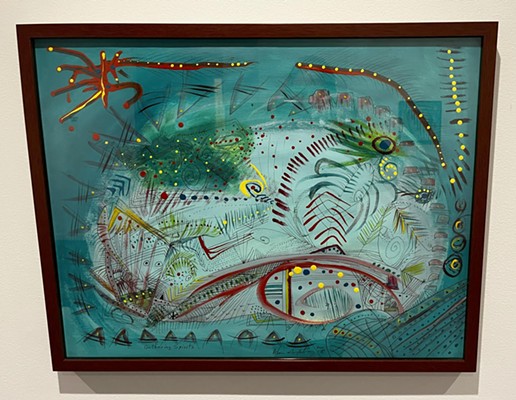
Gathering Spirits 2000
One of the works in the Marcia Hennessy Collection. “Alan painted this work listening to Glenn Gould’s music,” writes Hennessy.
Syliboy echoes this. His show didn’t set out to become his largest retrospective show yet—rather, Syliboy began with wanting to honour the private collection of long-time supporter and friend, Marcia Hennessy, who had collected over 100 works over three decades, and had recently died in 2020.
Syliboy and Edmonds worked with the Hennessy family who donated works from the collection to the show, and flew in for an emotional opening to the exhibit back in May.
Hennessy, who lived in upstate New York, first discovered Syliboy’s work in a show in Toronto “and just fell in love with it and bought several works then and there,” says Edmonds. “Over time, they started writing to each other—he would send her images of what he was working on and she would buy them—and he was the only artist she collected.”
“She curated everything in there,” says Syliboy, pointing to Hennessy’s collection in the gallery. “All the 100 pieces she bought, she’s the one that chose them so she’s a curator.”
Syliboy says her support made a significant difference for him because he was a struggling artist and a single parent with three kids at a time when Hennessy was consistently buying his work.
“She really helped me and supported me,” says Syliboy. “I almost feel that she was sent to me because it was amazing.” Sitting in Hennessy’s collection within the show for the first time, says Syliboy, was very emotional as some works are from 30 years ago “and every one of them is tied to Marcia.”
While it started with Hennessy, it has exploded across the entire gallery space into so much more. This is the way things go for him, says Syliboy. “I don’t have a long term plan, I don’t map out anything, I just let things happen and progress.”
Syliboy reflects, saying “everything I do is like that—I don’t have roadmaps, I don’t use them—it's about whatever is happening in the moment and, musically too, everything I do is tied to that.”
Jam sessions from Syliboy’s band Alan Syliboy & The Thundermakers can be heard floating alongside his work in the back area featuring Hennessy’s collection of his paintings and drawings.
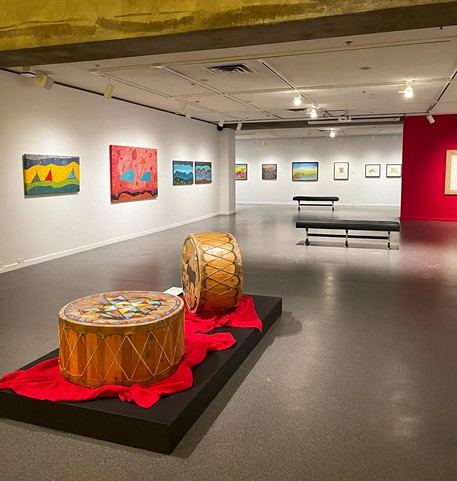
When you first enter the show, you’re struck by the vibrant and evocative Mi'kmaw petroglyph-inspired-wall that was made especially for the show, meaning it will disappear in a month. It’s a must-see-in-person before then.
The large snake can even be spotted through the hexagonal windows looking into the gallery from the floor above in the Dalhousie Arts Centre. Catching these sights from above extends the length of the creature and its legend outside of the show.
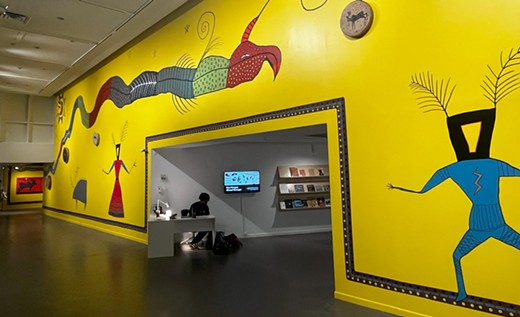
Jipijka’m 2024
“Jipijka’m (Great Horned Serpent) is a powerful spiritual being able to take on human form and can therefore live on land and in water,” writes Mi’kmaw curator Diane Langevin beside the mural. “When it moves it is said that the ground begins to shake. The horn of the jipijka’m is also a powerful object that is often incorporated as a way of teaching in Mi’kmaq stories. Jipijka’m is a medicinal protector and spirit ally of the puoin (shaman).”
The horned serpent, called Jipijka’m in Mi’kmaw, is a mythological creature. Its legend is fleshed out by Mi’kmaw curator and educator, Diane Langevin, who worked with Dal on the interpretation of parts of Syliboy’s show that appear in text form beside his work.
Langevin is completing her Masters in Art Education at the Nova Scotia College of Art and Design (NSCAD) in Halifax. Her own research focuses on museum and curatorial studies and her thesis work is structured around Indigenous resurgence through research, storytelling and toy-making.
The Jipijka’m has become the centre of Lanvegin’s work. “It has a living history here which is really interesting.”
Langevin explains the living legend of the Jipijka’m: it’s a semi-aquatic shape-shifting creature that lures people to their deaths which she points out as a definite highlight of the show.
Of the Jipijka’m mural in Syliboy’s show, Langevin says “you can’t miss it.”
Education cards written by Langevin accompany Syliboy’s work and expound upon Mi’kmaw culture, art, language and storytelling across the gallery. “The ways that Indigenous research takes place and the ways that art can lead to research for Indigenous people, is a healing way for us to create research,” says Langevin. “It’s been a very great exhibition for me to be a part of.”
Edmonds says she asked Langevin to join the team because she understands “the dynamic of working on a project when it's not your particular culture.” Edmonds says she's very interested in cross-cultural curating and that, with The Journey So Far, she wanted to bring in a Mi’kmaw curator educator voice through Langevin. As well, she wanted to show the collaborative and inspirational nature of Syliboy’s work over the decades.
“With this show, I want to celebrate and support [Syliboy] as an artist—but it's beyond the celebratory because he's had an impact on other artists, he's had an impact as an Indigenous artist, but hasn't been in those major exhibitions that have featured Indigenous artists,” says Edmonds. She nominated Syliboy for a Sobey Art Award last year, which he was long-listed for.
“I feel like he should get a Governor General’s Award for visual arts for the work that he's doing,” says Edmonds, “but there's no critical document that puts his work into context like this does.”
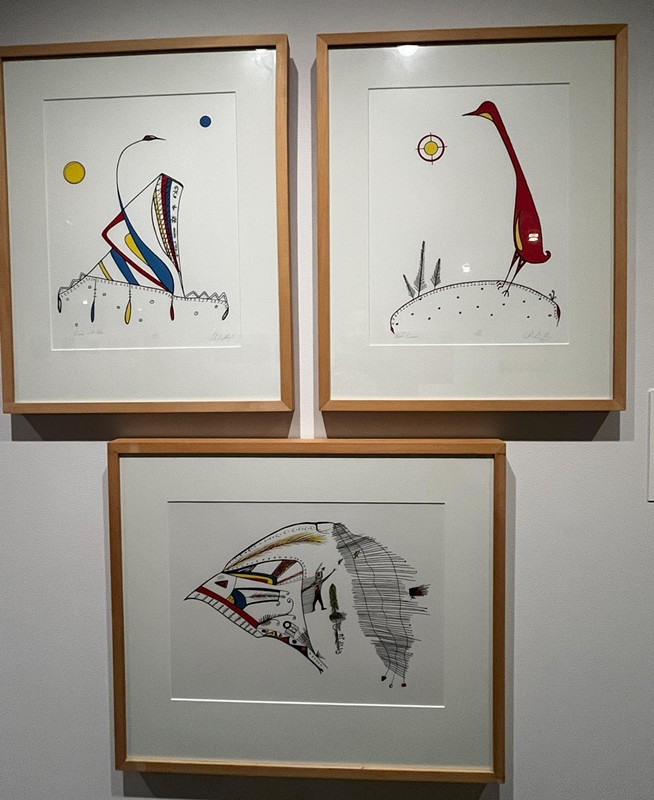
Clockwise from left: Goose on the Water 1995, Red Crane 1995 and Hawk 1995.
The red tmkwaliknej (crane) is recreated from petroglyphs found in our area,” writes Syliboy. “This image has been great to work with over the years. It was an easy choice when I was looking for my studio signature image.”
The Mi'kmaw four direction colours appear in these limited-edition prints made by master-printer Susan Wakefield in the mid '90s, says Syliboy. He says he was also honouring Ojibwa artist Benjamin Chee Chee who loved to work in this kind of style. "I really appreciate his work and that's why I sort of thought of him when I when I made this," says Syliboy.This context includes over 50 years of art starting from the early ’70s. What’s more, says Edmonds, because it can be much more difficult for self-taught artists to get into public galleries, the show itself offers commentary on the nature of gallery spaces and their relationship with art institutions.
Sylliboy started drawing and making images when he was very young. He started sharing them with people outside of his family while attending an English-language Catholic school in Truro.
Syliboy recalls that, at school, “I wasn’t allowed to speak my language when I was there… which was a disadvantage from the start—English wasn’t really my first language at the time.”
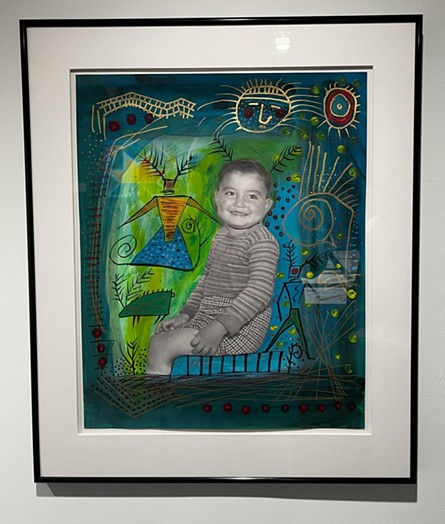
Syliboy spoke Mi’kmaw with his family in the community of Millbrook First Nation where he’s lived all his life. However, he was prevented from speaking Mi’kmaw at school. “I couldn’t relate,” he says, “and I don’t think I was ready for that emotionally.”
School wasn’t for him and he struggled. In those days, says Syliboy, "if you didn’t pass, they just kept you behind—so I failed three times and ended up way older and bigger than my classmates in the end.”
Syliboy says the only positive experience he had at school was the support of his classmates, “who were my first audience, actually.” They would request drawings from him which, because there weren’t any art classes to speak of, Syliboy was producing drawings and passing them around, “as a sort of an underground operation.”
When Syliboy was in his late teens, he was recruited by the influential Maliseet artist, educator and activist, Shirley Bear, to join her six-month program whose purpose was to teach Indigenous artists how to teach Indigenous art within Indigenous communities across New England.
“That was very radical at the time,” says Syliboy, “because we were always taught art from outside and never from ourselves.” Syliboy says Bear, who died in 2022, “was a very radical person and a trailbreaker—to make the program 100 per cent Indigenous, it just wasn’t done then.”
One of the earliest works within Syliboy’s show is a landscape painting of a sunset in Whycocomagh First Nation from 1972. This early painting is related to Bear’s earlier work, who was a portrait painter at the time.
“I learned from her and did what she did–but she brought me the book of petroglyphs.” These would become highly influential in Syliboy’s work and research from that point on.
Within the show, Edmonds has included two shelves of books related to The Journey So Far.
The top shelf—or “exhibition resources''—holds two unassuming paper-bound books from the 1970s borrowed from the Nova Scotia Museum. One is Rock Drawings of the MicMac Indians by Marion Robertson, and is the same copy Syliboy received from Bear as a young artist.
Syliboy says that, of the artists in Bear’s program, “we wanted to have a purpose, didn’t want to be typical, landscape or realist painters and we wanted to contribute something.”
Discovering the book of petroglyphs became a guide, “because we didn’t know about them and Mi’kmaw people didn’t know about them either—so, bringing them back and reclaiming them became really important.”
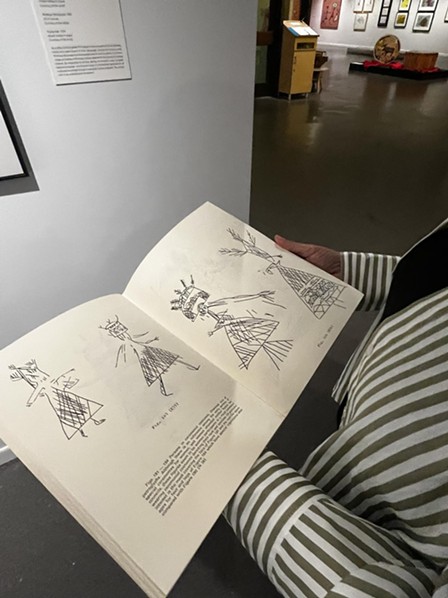
What’s also important for Syliboy is showing that Mi’kmaw representations, stories, art and culture are not static, but evolving and contemporary, too.
Pointing to the figure of a Mi’kmaw woman in a red dress that’s part of the exhibit’s gigantic mural, Syliboy says this is one of his favourite designs that’s also entirely unique to the Mi’kmaq.
“The whole shape, including the fir bows and the feathers, is Mi’kmaw found in petroglyphs—I find that it’s a very powerful image.”
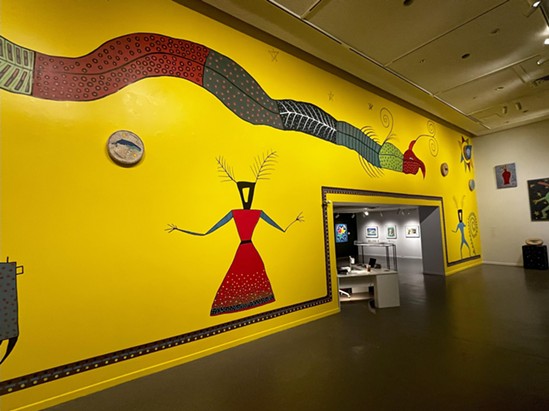
Syliboy painted the woman in a red dress to signify the National Inquiry into Missing and Murdered Indigenous Women, Girls (MMIWG). “It’s contemporary to what’s happening right now but it’s still a link to the past that’s brought together in this piece.”
In the first smaller gallery room of the show is an early painting which Syliboy says is one of the only works where petroglyph figures are represented exactly as they’re found in the book. Otherwise, Syliboy never makes direct copies but elaborates and draws on their forms.

These petroglyph drawings “started the journey,” says Syliboy, but along the way he’s added research and collaboration from archaeologists, different artists, historians and more “to find everything I could and incorporate it.”
Characters found in petroglyphs have evolved into new forms, including popular repeating figures in Syliboy’s work, like “The Red Crane,” “The Solar Family” and “Little Thunder.”
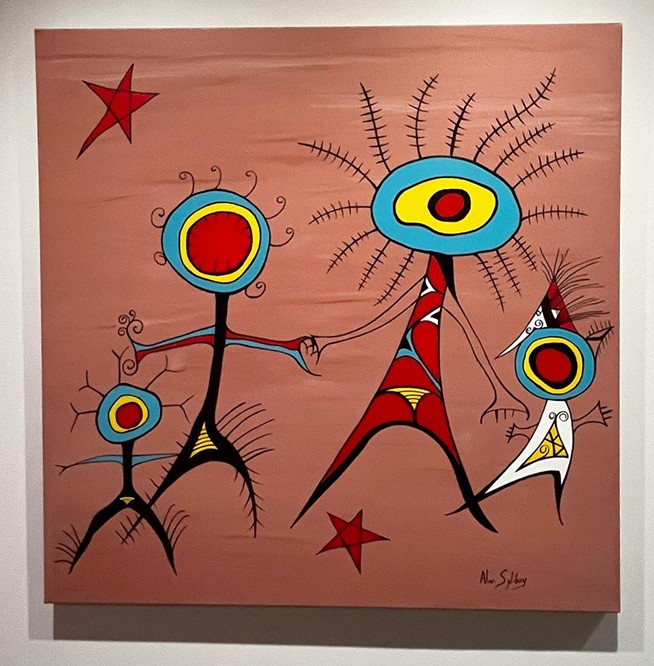
The Solar Family 2002
“To me, this is a peripheral image and evokes that the sun was a big part of our lives, with the sun dance ceremony dedicated to the sun and to the people,” says Syliboy.
Beside the work, he writes “Indigenous people believe that unless the sun dance is performed each year, the earth will lose touch with the creative power of the universe, thereby losing its ability to regenerate.”
The red ochre that appears in the background in wisps is a direct connection to the history and culture of the Mi’kmaq as well, Syliboy explains, who used it to paint themselves and used it in burials. It’s a material used throughout much of his work.
“Ever since Little Thunder showed up, he’s been a big part of everything I do.” Little Thunder also inspired Syliboy’s band’s name—The Thundermakers. [pull quote]
He first appears in a Mi’kmaw legend and book called, The Stone Canoe.
“This is one of the legends that weren’t corrupted, that weren’t translated into English,” says Syliboy. The Mi’kmaw speaker wrote it down more than 175 years ago and the next step was to translate that into English, he says. But that part of the process didn’t happen. That meant it was kept “in its pure form: as a Mi’kmaw story written in Mi’kmaw.”
Syliboy says that’s unusual. There are maybe two stories that are like that, which are “uncorrupted by another culture.” These are The Stone Canoe and The Woman On The Island. Syliboy says that’s what makes them his favourites.
The Stone Canoe: Two Lost Mi’kmaq Texts, published by Gaspereau Press in 2007, is part archival manuscript, part story, part illustration. It includes new English translations Mi’kmaw speaker and teacher, Elizabeth Paul, commentary on translation of stories from essayist and poet Peter Sanger, and ink drawings from Syliboy. The book shares these stories that have inspired much of Syliboy’s work since finding them, including the emotional centrality of the character, Little Thunder.
In The Stone Canoe story, we’re introduced to the characters Little Thunder and his father, Big Thunder.
“To me, it made sense that he would be Big Thunder someday,” says Syliboy, “and that's why my book The Thundermaker is really about the process of him becoming Big Thunder.”
Syliboy is the author of many books written in English and Mi’kmaw including this one, published in 2015, along with other popular works like Wolverine and Little Thunder and Mi’kmaw Waisisk/Mi’kmaw Animals.
For Thundermaker, Syliboy says “I researched how Mi’kmaw children were taught and brought up in the community and I put that research into my book to make it a legitimate story about a Mi’kmaw child.” It’s the process, the evolution, the cycle of re-emergence.
Signed copies of The Thundermaker are available for cash purchase within the Dal Art Gallery, along with more of his signed books, and they are going fast.
In 2025, the DAG will publish a catalogue of the show, with writings from Edmonds, Syliboy and Langevin.
While there’s still one more month to check out this sprawling show, multiple visits come highly recommended. What’s more, Syliboy will be giving an artist talk within his show this Saturday July 20 from 2pm to 3:30pm, joined by Edmonds and opened by Langevin. It’s free and open to the public and there’s plenty of room in the gallery.

